Tech
Amazon’s fuel surcharge might make your impulse buys more expensive
Third-party sellers are dependent on Amazon to help fulfill orders and now they'll be faced with a five percent fuel surcharge on April 28.

To deal with inflation and gas prices endless creep upwards, Amazon announced that it would be applying a five percent “fuel and inflation surcharge” to sellers that are a part of its Fulfilled by Amazon (FBA) program.
Third-party sellers will be saddled with the new surcharge starting April 28, and will likely be forced to pass on the extra cost to customers.
It’s a mess — Some kind of temporary fee seemed unavoidable, at least from Amazon’s perspective. The company told CNBC it expected its shipping business to normalize in 2022, “but fuel and inflation have presented further challenges.”
“It is still unclear if these inflationary costs will go up or down, or for how long they will persist, so rather than a permanent fee change, we will be employing a fuel and inflation surcharge for the first time,” Amazon’s spokesperson told CNBC.
Inflation hit 8.5 percent in March, The New York Times reports, with rising gas prices following Russia’s invasion of Ukraine being one of the main contributors.
Passing on the cost — Other supply chain providers use similar surcharges to offset rising fuel costs, so Amazon isn’t entirely alone here. The company’s 24 cent surcharge per unit is less than FedEx’s 49 cents, or UPS’ 42 cents, but it has to be taken into account with other fees sellers are expected to pay to participate in FBA in the first place.
Based on Bloomberg’s reporting, Amazon merchants do plan on passing the new costs on to their customers in order to keep their businesses afloat. Dealing with customers who don’t want to accept the new prices, however temporary, is a whole other problem.